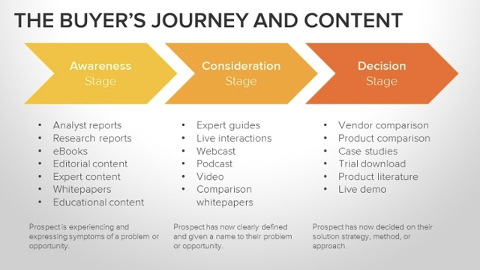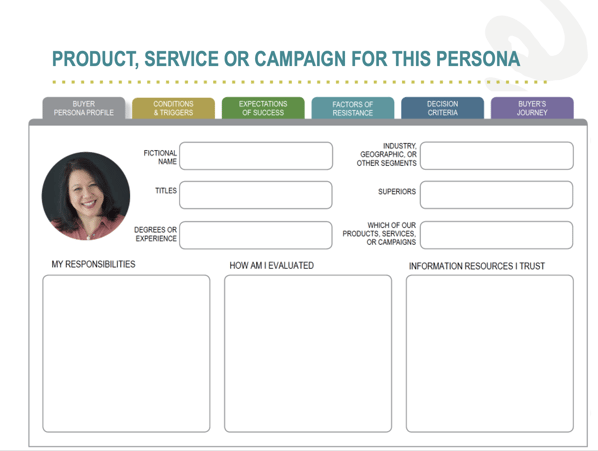
You have been in the marketing world long enough to know about the concept of personas. These semi-fictional portraits of your best customer you are marketing to can help you write more inspired messaging as well as present this information in a way your ideal audience likes to see it. However, personas are only as good as the work that goes into creating them. An imagined persona with loose demographic information doesn’t give you the information you need to make a targeted marketing strategy. Instead, thorough research, detailed interviews and careful analysis of real data about your existing customers are essential to creating a persona that works for your business.
Why You Need a Persona
As a marketing professional, you might need to occasionally remind your junior staffers that marketing supports sales. Yes, you are managing the brand and supporting communications and project managing web projects, BUT, ultimately, your goal is to create revenue. Every business exists to generate revenue. So, we think of personas as active buying customers. The purpose of a persona is to create content that helps to sell the active buyer through the stages of the buying journey (awareness, consideration, and decision). Every piece of content you produce should be useful to your sales team.
The purpose of a buyer persona is to direct your content plan. Your content plan should address your customer’s needs, questions, challenges, and expectations so that when they are in the decision stage of the buyers journey, your products, services, and content has earned their business.
This will also help you to determine where your customers spend time on the web and in the world, giving you insight into how to communicate with them, how to reach new customers and know where and how to promote your business.
The most critical outcome is that you will gain an understanding of how your customers make purchasing decisions, so you can better target your marketing and move them into and through your flywheel.
Getting Started
The first step to creating a buyer persona is to determine what tools you want to use to collect persona details. Here are the options:
- Survey
- Interview
- Talk to co-workers/sales
- Use lead intelligence from web data – what do they click on, look for trends
- Keywords on industry blogs
- Ask questions on social media
- verbatim quotes from people who have recently made the decision to solve a similar problem
We almost always choose interviews and the sales team as part of the process. Sales knows the customer best. A great sales person will impact your content in wonderful ways.
To encourage prospects or customers to agree to interviews, consider offering a small incentive such as a free meal or a gift card. Also, make sure it is clear this is not a sales call and set a time limit on how long the interview will take. You’re not trying to sell them anything, you want to learn from them about their lives, goals, and challenges.
The Interview
Once you have your interviewees, it’s time for the interview! For the first part of the interview, create an interview script with questions on their demographics, role, challenges, how they imagine success, and the reasons they chose you.
Create a fictitious profile that you can point that gives them a name and other attributes. Then, focus in on the insights that will help you create content that matches up with what your personas need. There are five insights that we focus on:
- Conditions and Triggers
- Expectations of Success
- Factors of Resistance
- Decision Criteria
- Buyers Journey
“learn what prospective customers are thinking and doing as they weigh their options to address a problem that your company resolves. This will reveal insights about your buyers’ decisions -- the specific attitudes, concerns and criteria that drive prospective customers to choose you, your competitor or the status quo. This will give you the knowledge you need to align your marketing decisions -- from positioning and messaging through content marketing and sales enablement – with your buyer’s expectations.”
5 Rings of Buying Insight™ for Buyer Personas
(source: Buyer Persona Institute)
Conditions and Triggers
What causes this persona to start looking for solutions like yours, and what is different about buyers who are satisfied with the status quo?
Tips and Examples
- Do not confuse conditions and triggers with pain points that you simply reverse-engineer based on the capabilities of your solution. These can also be orders from the C-suite, new market factors, or a simple change in philosophy.
- You want to understand the personal or organizational circumstances that cause your buyers to allocate their time, budget, or political capital to resolve the issues or the pain.
expectations of success
What operational or personal results does your buyer persona expect to achieve by purchasing this solution?
Tips and Examples
- Expectations of success resemble benefits, but this insight is far more specific and written from the buyer's perspective.
- For example, you might currently emphasize your solution's impact on cost reduction, but an insightful buyer persona would identify the category and degree of cost reduction that buyers anticipate. They may perceive a job promotion with success.
- Examples of personal outcomes include impressing peers, widening the buyer's sphere of influence, gaining better quality of life because of time efficiency, or increasing their ability to control something about their environment.
factors of resistance
What concerns cause your buyer to believe that your solution or company is not their best option or can get in the way of moving forward?
Tips and Examples
- Expect to gain insights into product or company-specific barriers. These kinds of barriers can be addressed in a smart content plan that renders them irrelevant or inconsequential.
- These perceptions often result from negative experiences with similar solutions, online interactions, or direct feedback from inside the organization.
- Other these factors relate to personal or business obstacles that prevent your buyer from investing in change. Examples include the need for business process change, lack of proof, gaining acceptance from end users, or other politically-charged issues.
Decision Criteria
Which aspects of the competing products, services, solutions or company does your buyer perceive as most critical, and what are their expectations for each? What are they weighing in their decision. Cost is often the biggest focus of conversation but it often is not the most important criteria. Consider quality, features, customer service, corporate responsibility, reputation, and other things as you explore this insight into your persona.
Tips and Examples
- You will know which of your capabilities has the most impact on your buyer's choice to do business with you.
- This insight informs messaging and content marketing decisions, clarifying both the buyer's questions and the answers they want to hear.
- For example, if the buyer wants a solution that is "easy-to-use", the Decision Criteria Insight specifies which aspects of the solution this persona expects to be "easy to use" and how they determine which solution is the easiest.
Buyer's Journey
This insight reveals details about who and what impacts your buyer as they evaluate their options and select one.
Tips and Examples
- To help you target the most influential buyer personas, this insight identifies which personas have the most impact on the decision to continue to evaluate your solution at each step in the process. (Tip: the economic buyer or decision maker isn't as influential as you think.)
- To help you prioritize your marketing investments, you need to know which resources the buyer trusts at each step of their evaluation for this decision. For example, a marketing executive would not rely on the same resources for decisions about web conferencing and off-site event planning.
- For persuasive messaging and content, the Buying Process insight specifies the Decision Criteria, Success Factor, and/or Perceived Barrier that has the most impact on the buyer's choice at each step.
Once your persona(s) is complete, you can map out that content plan with the buyer's journey in mind. Here is an infographic from HubSpot that illustrates content types for different parts of the journey.

Now you are ready to collect information and conduct your interviews. You will want to take good notes or even record your interviews. Don’t ask leading questions to make the interviewee say what you want to hear and don’t give away the answers. A little silence after a question gives them time to think and puts on a touch of pressure that keeps their answers authentic. Remember follow-up questions are crucial for uncovering the nuances of your persona. A great follow-up question that works for most situations is "tell me more" or “why?”
Creating Your Persona
Once you’ve gathered data from your customer research and your interviews, it’s time to knit this information into a cohesive buyer persona. Begin by recording the basic demographic information of your buyer persona. Also record their goals, challenges, motivations, where they look for information, and how they like to be communicated with on a day to day basis. Distill all of your interview notes into two-to-five buyer personas. Using a persona worksheet like this one can help organize your thoughts and make sure you’ve covered all your bases.
Here is an example of what the first page of your final buyer persona may look like. You may view the full example here: https://www.buyerpersona.com/buyer-persona-example

Using Your New Persona
Use your buyer personas. Look at what they like about your company and do more of that. Also, find ways to stop doing what they don’t like. And, ensure your messaging clearly shows that you understand their challenges and have a solution for them. From now on, everything you do should be with this persona in mind. You can create content that speaks to your persona’s challenges, write blog posts that answer their common questions and concerns, and create branded content that shows your company is in line with their goals and committed to solving their pain points. Post this content on the platforms your persona goes to when they’re looking for information, be that Facebook, YouTube, or e-newsletters.
The persona’s usefulness doesn’t end with marketing. Your next task is to get everyone in the company on the same page about your marketing goals. The sales team, marketing department, human resources, C suite and other departments can all benefit from keeping your persona in mind.
Buyer personas result in a better brand experience that equates to more leads that are more sales-ready, because you’re reaching the right people by leveraging what they want, rather than by pushing what you want. A well-researched buyer persona adds a human face to your marketing strategies and tactics and, with the proper consideration, can revolutionize the way you go about marketing. So, go forth! Begin your journey to more personal and effective marketing!
Topics: digital marketing, Marketing Agency, buyer persona






